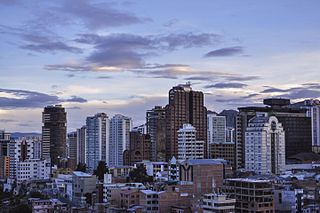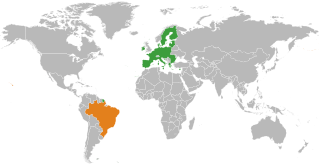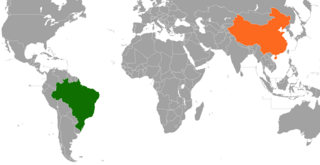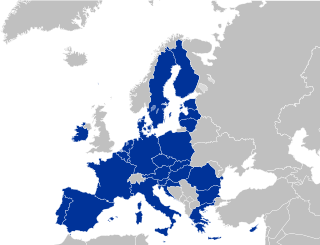 | |
European Union | Argentina |
|---|---|
Argentina has strong cultural and historical links to the European Union (EU) (particularly through immigration from Spain and Italy) and the EU is Argentina's biggest investor. [1]
 | |
European Union | Argentina |
|---|---|
Argentina has strong cultural and historical links to the European Union (EU) (particularly through immigration from Spain and Italy) and the EU is Argentina's biggest investor. [1]
Argentina was the first Latin American country to formalise relations with the EU under a 3rd generation cooperation agreement. The Framework Trade and Economic Co-operation Agreement between the EU and Argentina entered into force in 1990 and includes two recurrent principles of their cooperation: the strengthening of democracy and human rights, as well as regional integration. An EU-Argentina Joint Commission has also been established. A number of sectoral agreements were established in the 1990s. The main focuses of cooperation are education and training; economic competitiveness; capacity‑building in the public and academic sectors. [1] Argentina is part of the EU's negotiating with the regional bloc Mercosur for a free trade agreement which will form the back bone of EU-Latin American relations. [2]
The EU is Argentina's second largest export market (after Brazil). Argentina's exports to the EU are mainly agricultural and other primary goods. The EU exports less goods to Argentina in return (giving the EU a deficit of €3.4 billion) but has a surplus in services of €0.4 billion. Further, being that the European Union is Argentina's biggest foreign investor, the entity accounts for half of Argentina's foreign direct investment (FDI). [2] The EU as a whole is Argentina's first partner in cooperation, the first investor and its second largest trading partner, with a trade volume of 18.1 bn. [3]
Mercosur was founded in 1991 by Argentina, Brazil, Paraguay and Uruguay with the signature of the Treaty of Asuncion. Venezuela is a full member since July 2012, Bolivia is in the process of becoming a full member since December 2012; while Chile, Colombia, Ecuador and Peru are associated states. Its Secretariat is based in Montevideo and it has a six-month rotating Presidency. In 1995, the EU and Mercosur signed an Interregional Framework Cooperation Agreement, which entered into force in 1999. A joint declaration annexed to the Agreement provides the basis for the political dialogue between the parties, which takes place regularly at Heads of State, Ministerial and Senior Official levels.
In 2000, the parties opened negotiations for an Association Agreement including three chapters: political dialogue, cooperation and trade. Negotiations were suspended in 2004 over fundamental differences in the trade chapter. Political relations continued, notably with the signature, during the EU-MERCOSUR Summit of Lima in 2008, of an agreement to expand relations to three new areas, science and technology, infrastructure and renewable energy.
After a six-year suspension, negotiations were re-launched in May 2010 at the EU-LAC Summit of Madrid and are ongoing. The objective is to negotiate a comprehensive trade agreement, covering not only trade in industrial and agricultural goods but also services, improvement of rules on government procurement, intellectual property, customs and trade facilitation, technical barriers to trade.
EU is Mercosur first trading partner accounting for 19.8% of Mercosur's total trade with the World and worth €109.895 billion in 2013. [4]
Argentina has been recording trade surpluses since 2001, mostly due to exports of agricultural products. Main exports are: cereals, fats and oils, beef and related products and dairy products (36 percent of total exports), motor vehicles and parts (12 percent); chemicals and related products (7 percent) and crude oil and fuels (5 percent). Main imports are: intermediate goods (29 percent of total imports), parts and accessories for capital goods (20 percent), capital goods (19 percent), fuels and lubricants (13 percent) and motor vehicles (8 percent). Argentina's main trading partners are: Brazil (21 percent of total exports and 29 percent of imports), China (7 percent of exports and 14 percent of imports) and United States (5 percent of exports and 10 percent of imports). Others minor trading partners include: Chile, Italy and Spain.
In June 2014, exports declined 2.6% over the same month last year (June 2013: +11.4% year-on-year), which followed the sharp 16.3% drop recorded in May 2014. The print, which marked the smallest contraction in seven months, mostly reflected a softer decline in shipments of fuel and energy as well as a healthy expansion in soybean exports as the harvest season reaches its peak.
A month-on-month comparison corroborates the slight improvement suggested by the annual figures. Exports expanded 8.0% on a seasonally adjusted basis in June 2014, which was well above the 2.0% increase recorded in the previous month.
Imports dropped 5.7% annually in June (June 2013: +5.5% yoy), which followed the 17.1% contraction observed in May. As a result, the trade surplus reached USD 1.4 billion, which was slightly up from the USD 1.2 million recorded in June 2013 and represented the largest surplus since May 2013. Moreover, this was higher than the USD 1.3 million surplus recorded in May of this year and exceeded the USD 1.2 billion surplus that market analysts had expected. In the 12 months up to June, the trade balance posted an accumulated USD 6.5 billion surplus (May: USD 6.4 billion).
According to analysts, Argentinean trade has been heavily damaged by tough government import restrictions, weaker demand from Brazil—the country's top trading partner—and high inflation, which is dampening the country's competitiveness. In addition, farmers continue to hoard grains and soybeans to hedge against the weak peso. The country, which has had no access to international capital markets since defaulting in 2001, depends heavily on commodity exports to draw the foreign exchange reserves required to fulfill its debt obligations. [5]
In the beginning of 2014, Argentina attempted to prevent Brazil, Uruguay and Paraguay to negotiate individually a schedule for opening markets with the European Union (EU), within the framework of the free trade agreement with Mercosur. Technicians of the two blocs that gathered in March from 2014 in Brussels did not reach an agreement because of the lack of ambition of the Mercosur proposal, says the Brazilian newspaper Folha de S.Paulo. Brazil and Argentina were in disagreement and Brazilian representative would have mentioned the existence of a B plan, which would consist of different rhythm for opening markets in each country.
However, Argentina would have blocked this option, fearful that their products could be replaced by European ones in the Brazilian market, one of the most important for Argentina. According to the newspaper Folha de S.Paulo, for the President of Argentina, Cristina Kirchner, the proposal would be “incompatible with the deeper integration of the bloc”.
Europeans would be disappointed by the possibility of a “grace period” for some products regarding the reduction of import tariffs. Argentina is insisting on this term, which would take certain products to be subject to the free market only in 15 years. While Brazil, Paraguay and Uruguay already included 87% of the products on an offer to the EU, Argentina says that it will not open more than 82% of its market. Mercosur and EU are trying to resume negotiations that were braked since 2003. [6]
EU-Latin America trade relations Latin America is the first priority for the profound economic, social, cultural and even family ties between the two sides of the Atlantic. The countries of the EU, Latin America and the Caribbean are natural allies, united by strong historical, cultural and economic ties and collaborate very closely at international level, where intense political dialogue at all levels are maintained.
The EU remains the main source of Foreign Direct Investment in the region: more than 40%. Europe invests in Latin America more than it invests in China, India and Russia together, and these investments are also growing progressively. Trade flows have doubled in the last decade to 202 billion Euros. The network of agreements that have been woven throughout the years has substantially contributed to it.
The European Commission aims to support the development of a legal framework that ensures the security and predictability for investments. For this reason the very first "missions for growth" were to Latin America. [7]
| EU – Argentina trade in 2008 [2] | ||||
|---|---|---|---|---|
| Direction of trade | Goods | Services | Investment flow | Investment stocks |
| EU to Argentina | €4.8 billion | €2.4 billion | €4.4 billion | €44.1 billion |
| Argentina to EU | €8.2 billion | €2.0 billion | €0.3 billion | €1.7 billion |

The economy of Paraguay is a market economy that is highly dependent on agriculture products. In recent years, Paraguay's economy has grown as a result of increased agricultural exports, especially soybeans. Paraguay has the economic advantages of a young population and vast hydroelectric power. Its disadvantages include the few available mineral resources, and political instability. The government welcomes foreign investment.

The economy of Bolivia is the 95th-largest in the world in nominal terms and the 87th-largest in purchasing power parity. Bolivia is classified by the World Bank to be a lower middle income country. With a Human Development Index of 0.703, it is ranked 114th. Driven largely by its natural resources, Bolivia has become a region leader in measures of economic growth, fiscal stability and foreign reserves, although it remains a historically poor country. The Bolivian economy has had a historic single-commodity focus. From silver to tin to coca, Bolivia has enjoyed only occasional periods of economic diversification. Political instability and difficult topography have constrained efforts to modernize the agricultural sector. Similarly, relatively low population growth coupled with low life expectancy has kept the labor supply in flux and prevented industries from flourishing. Rampant inflation and corruption previously created development challenges, but in the early twenty-first century the fundamentals of its economy showed unexpected improvement, leading Moody's Investors Service to upgrade Bolivia's economic rating in 2010 from B2 to B1. The mining industry, especially the extraction of natural gas and zinc, currently dominates Bolivia's export economy.

Relations between the European Union (EU) and the People's Republic of China (PRC) or Sino–European relations are bilateral relations that were established in 1975 between the PRC and the European Community. The EU is the PRC's largest trading partner, and the PRC is the EU's largest trade partner.

Foreign trade of Argentina includes economic activities both within and outside Argentina especially with regards to merchandise exports and imports, as well as trade in services.
In its economic relations, Japan is both a major trading nation and one of the largest international investors in the world. In many respects, international trade is the lifeblood of Japan's economy. Imports and exports totaling the equivalent of nearly US$1.309.2 Trillion in 2017, which meant that Japan was the world's fourth largest trading nation after China, the United States and Germany. Trade was once the primary form of Japan's international economic relationships, but in the 1980s its rapidly rising foreign investments added a new and increasingly important dimension, broadening the horizons of Japanese businesses and giving Japan new world prominence.

Soviet foreign trade played only a minor role in the Soviet economy. In 1985, for example, exports and imports each accounted for only 4 percent of the Soviet gross national product. The Soviet Union maintained this low level because it could draw upon a large energy and raw material base, and because it historically had pursued a policy of self-sufficiency. Other foreign economic activity included economic aid programs, which primarily benefited the less developed Council for Mutual Economic Assistance (COMECON) countries of Cuba, Mongolia, and Vietnam.
Trade is a key factor of the economy of China. In the three decades following the dump of the Communist Chinese state in 1949, China's trade institutions at first developed into a partially modern but somewhat inefficient system. The drive to modernize the economy that began in 1978 required a sharp acceleration in commodity flows and greatly improved efficiency in economic transactions. In the ensuing years economic reforms were adopted by the government to develop a socialist market economy. This type of economy combined central planning with market mechanisms. The changes resulted in the decentralization and expansion of domestic and foreign trade institutions, as well as a greatly enlarged role for free market in the distribution of goods, and a prominent role for foreign trade and investment in economic development.

Foreign relations between the Argentine Republic and People's Republic of China has existed for decades. Both countries established diplomatic relations in 1945 as the Republic of China and again on March 19, 1972, with the PRC.

Moroccan trade is still dominated by its main import and export partner France, although France's share in Moroccan trade is declining in favour of the US, the Persian Gulf region and China. If seen as a single entity, the EU is by far Morocco's largest trading partner.

Brazil and the European Union established diplomatic relations in 1960. The European Union and Brazil have close historical, cultural, economic and political ties. At the 1st EU-Brazil summit, in 2007, Brazil entered in a strategic partnership with the European Union, strengthening their ties. This new relationship places Brazil high on the EU's political map.

Brazil–China relations are the current and historical relationship between Brazil and China. Relations between Brazil and China began in the early nineteenth century and continued until 1949, when they were disrupted by the creation of the People's Republic of China (PRC). Diplomatic relations between the PRC and Brazil officially began in 1974 with agreement on the establishment and operation of Brazil's embassy in Beijing and China's embassy in Brasília. Since then, bilateral ties have developed mostly based on non-interference, equality, and mutual benefit (win-win).

The Southern Common Market, commonly known by Spanish abbreviation Mercosur, and Portuguese Mercosul, is a South American trade bloc established by the Treaty of Asunción in 1991 and Protocol of Ouro Preto in 1994. Its full members are Argentina, Brazil, Paraguay, and Uruguay. Venezuela is a full member but has been suspended since 1 December 2016. Associate countries are Bolivia, Chile, Colombia, Ecuador, Guyana, Peru, and Suriname.

Mexico and the European Economic Community (EEC) signed an agreement intending to foster economic and trade relations on 15 July 1975. Mexico and the European Union (EU) have had a free trade agreement since 2000 and the two benefit from high investment flows.

Relations between the European Union (EU) and Japan date back to 1959. They have a strong trade relationship, particularly in investment flows.
The European Union and Indonesia have built robust commercial relations, with bilateral trade amounting to approximately €25 billion in 2012 resulting in a sizeable €5.7 billion trade surplus for Indonesia with the EU. As of 2012 EU and Indonesia has been marked by an upward trend. Whereas total trade was worth almost €16 billion in 2009, by 2011 it had already reached €23.5 billion.

Brazil–Egypt relations are the historic and bilateral ties between the regions that now constitute modern Brazil and Egypt. Bilateral relations were established in 1924, and Brazil currently operates an embassy in Cairo, while Egypt has an embassy in Brasilia and a consulate-general in Rio de Janeiro. Both countries generally enjoy friendly ties and mutual agreements on many important global issues such as disarmament, nuclear non-proliferation and environmental issues among others. In addition to that, both are member states of the Summit of South American-Arab Countries in which they have signed agreements on cooperation in many different fields.
The European Union–Moldova Deep and Comprehensive Free Trade Area or EU–Moldova DCFTA is a free trade area between the European Union and Moldova. The DCFTA is a part of Moldova's EU Association Agreement. It allows Moldova access to the European Single Market in selected sectors and grants EU investors the same regulatory environment in the associated country as in the EU. The first countries to ratify the agreement with the EU were Moldova and Georgia, thus the agreement officially entered into force in July 2016, although parts of them were already provisionally applied. However, because of political instability in Ukraine, the agreement with Ukraine was provisionally applied on January 1, 2016. Only after almost one year after the agreement officially entered into force in Moldova and Georgia, the agreement finally entered into force on September 1, 2017 in Ukraine.

The European Union–Mercosur free trade agreement is a proposed free trade agreement on which the European Union and Mercosur reached agreement in principle in 2019. The planned deal was announced on 28 June at the 2019 G20 Osaka summit after twenty years of negotiations. The agreement is criticized by NGOs, scientists, unions, farmers and indigenous people.
The trade policy of Switzerland refers to Switzerland's approach to importing and exporting with other countries.